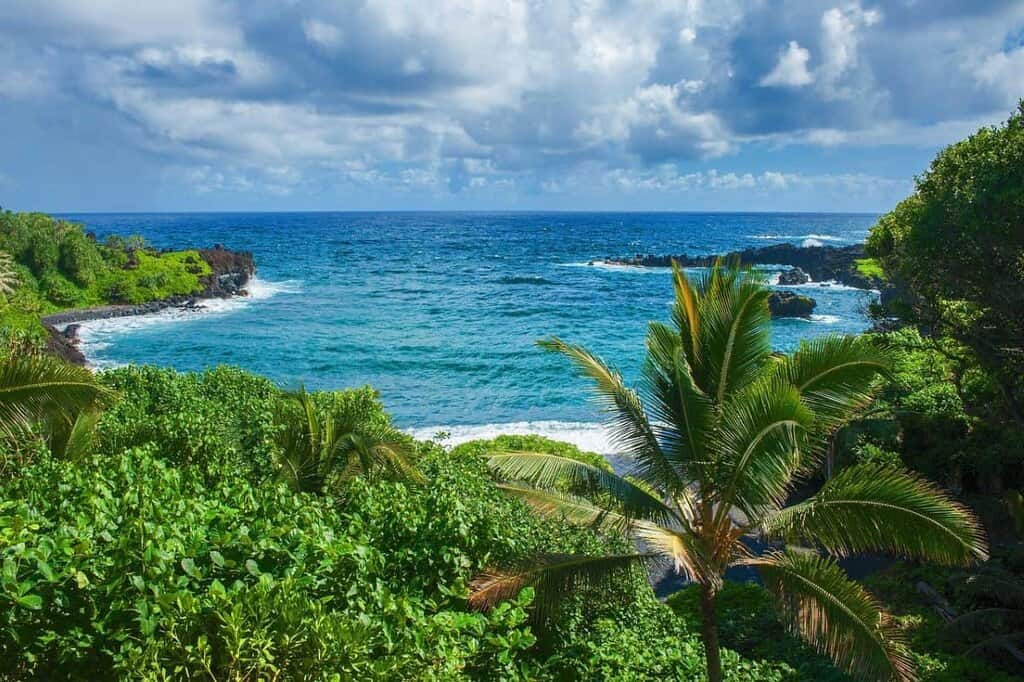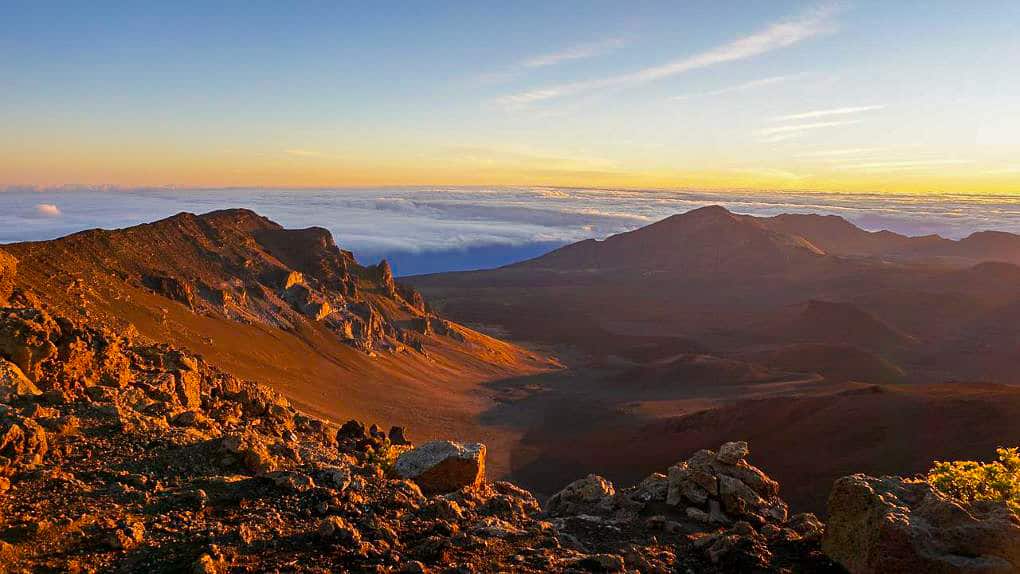Table of Contents
Updated October 2024
Take an epic drive along the stretch of one of the most scenic roadways known as the iconic Road to Hāna (Highway 36). To truly experience Maui, drive the road to Hana for a once-in-a-lifetime experience. A tight road goes through a green rainforest with views of waterfalls, beaches, and the blue ocean. The drive on the road to Hāna twists and turns through 617 curves as it hugs the coastline of Maui, crossing 59 one-lane bridges. The entire road is 64.4-mile-long.
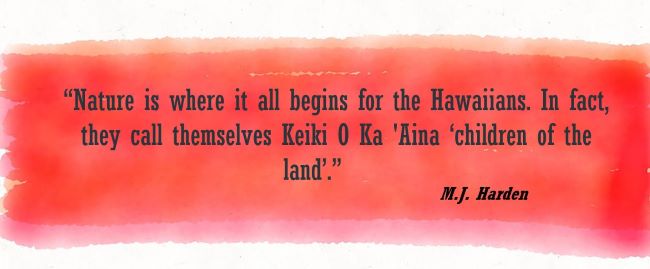
There are two options for traveling on the road to Hāna.
- First option: Book a full-day sightseeing tour with an experienced guide with narration of historic, cultural and flora and fauna. The driver will navigate the harrowing road, and you can sit back and take photographs. You have little control over the time at each stop. The all-day tour will take you full-circle around the very diverse windward of Maui.
- Second option: Rent a car and download the Road to Hana ShakaGuide app, and drive yourself.
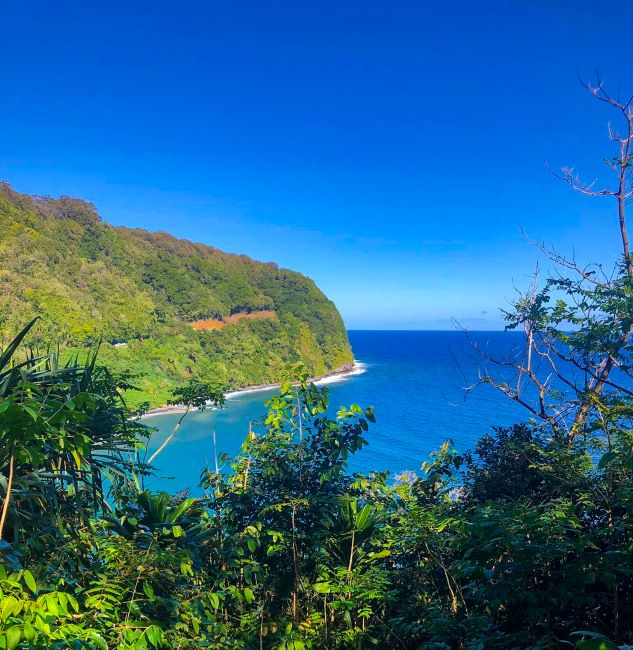
Once in a Lifetime Drive the Road to Hāna Guide
Our tour guide picked us up at our hotel in Kaanapali and dropped us off at the end of the tour. We had a large, comfortable and clean air-conditioned van greet us in front of the lobby of the Royal Lahiana resort, exactly on time. With a driver, you can unwind and admire the amazing road views. They also know where to park at all the best stops. Our guide was extremely knowledgeable about Hawaiian history and culture. Since there were only six of us, the tour was highly personalized.
On our first trip, we opted for a small group tour with a guide. However, we did a return trip with our rental car to trek the outdoor trails we missed with the guided tour.
This post may contain affiliate links, meaning if you purchase something through one of these links, we may earn a small commission at no extra cost to you! Read the full disclosure policy here.
Things to do on the Road to Hana: Driving the Road to Hāna-Ho’okipa Beach Park
This was our first stop of the morning, just outside Paia Town. Windsurfers around the world know the famous beach as the holy grail of windsurfing spots. Papa is the Hawaiian word for the flat, table-like shelf of an exposed reef which fronts the beautiful golden sands of Ho’okipa. We hung out, and the surfing was incredible to watch!
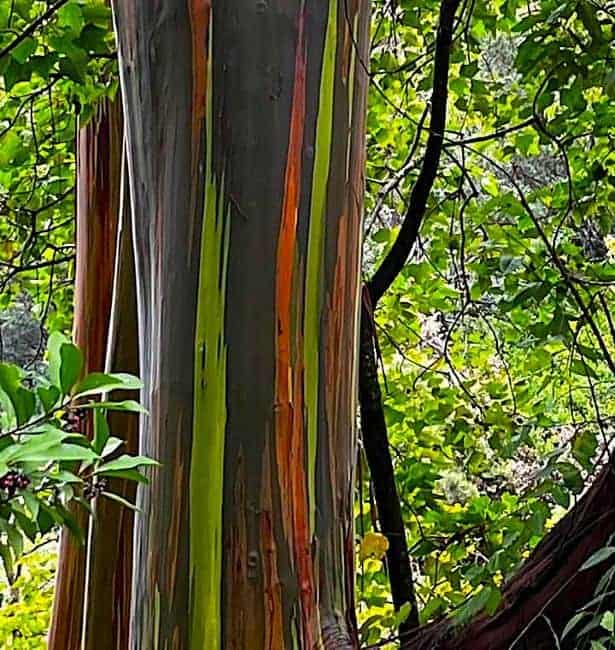
Not too far down the road at mile marker 7 are the painted trees. They are natural, brightly colored rainbow eucalyptus trees. Uniquely known for its gorgeous bark that peels away in strips, revealing hues of green, blue, and red. The mature trees may reach a height of 100 to 150 feet. The Ke’anae Arboretum also has a grove of trees, along with other unique species of plants.
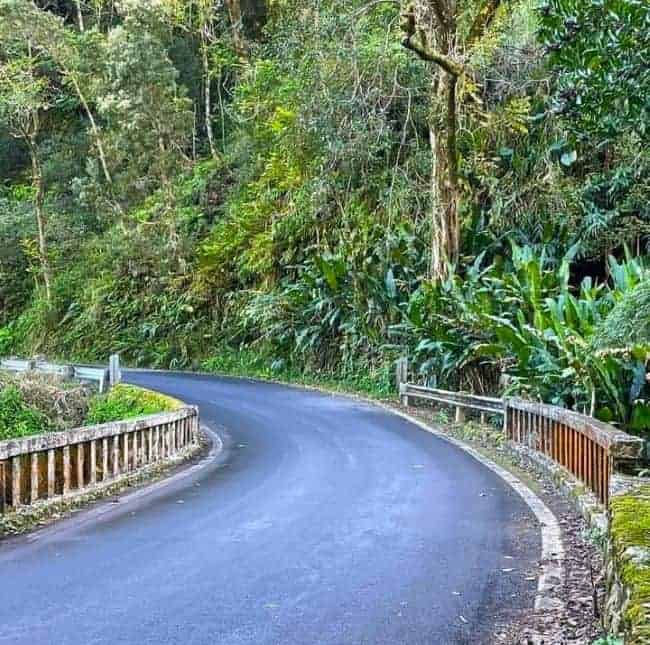
Exploring the Road to Hāna Stop – Puohokamoa Falls
This morning, Puohokamoa Falls is the first waterfall we encounter at mile marker 11 on the road to Hana. The Upper Falls cascade 20-feet into a small pool ideal for swimming or wading. You can pay the $15 to the Garden of Eden Arboretum and get views of the falls. However, if you want to get closeup views, park immediately after the bridge and walk the short boulder scramble to get wonderful photos of the falls. When we did this trip in the early morning, we had the pool to ourselves.
Note: There is now a sign stating private property, and they fenced the trail topped with barbed-wire and flash flood warning signs.
You can take the hidden trail to the more impressive 200-foot Lower Puohokamoa Falls. This trail leads below the highway and is steep and muddy, so wear hiking boots. Luckily for our group, the falls were flowing full tilt from the increased rains the evening before.
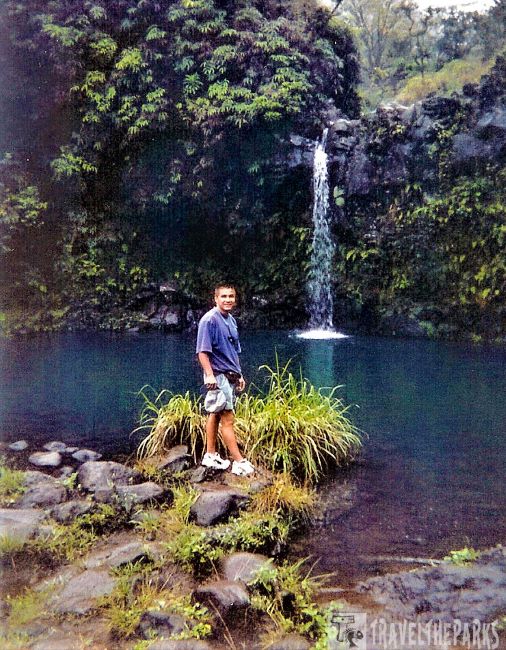
Drive the Road to Hāna Stop – Waikamoi Nature Trail
This trail at mile marker 9 provides an opportunity to get out and stretch along the road to Hana. It is a moderate 0.9 mile out and back trail. It takes about 30 minutes to walk. This old growth cloud-forest has an incredible amount of biodiversity. Lush vegetation and wildflowers line the jungle path. The smell of the eucalyptus trees was refreshing. There are a few lookouts along the trail. The trail may be muddy after rain, and you will need mosquito spray. The trail does not reach the Waikamoi Falls. Though you can see it later, it wasn’t obvious to us. Trees obscure its view. It is only a small waterfall near mile marker 10 at the 1911 bridge. There is a larger waterfall above, but it requires a hazardous rock scramble through the dense tropical rainforest.
Back on the road, we were in awe, as endless wonders seemed to be around every corner. Haipua’ena Falls at mile marker 11 is a short walk to a small waterfall with a pool. This is a beautiful spot to have a refreshing dip in the pool.
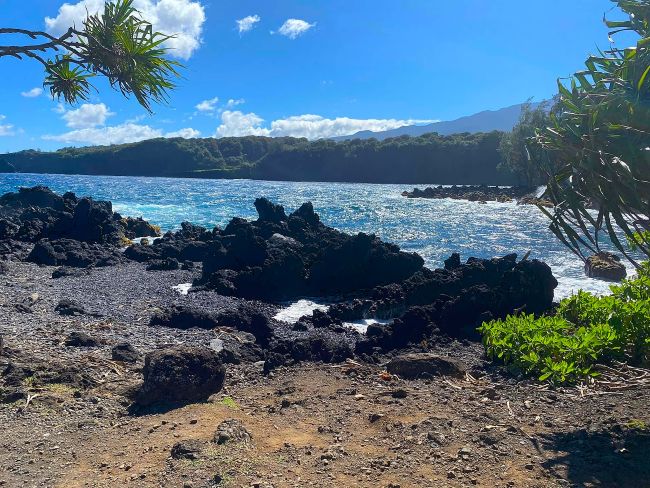
Drive the Road to Hāna Stop-Ke’ane Peninsula-Home of Taro
Many years ago, a small village occupied the rugged shoreline of the peninsula. In 1946, a massive tsunami inundated the picturesque village. Triggered by a magnitude 8.6 earthquake off the Aleutian chain of islands in Alaska, the wave reached 20-30 feet high when it hit the beach. The only surviving structure was the Old Stone Church, called “Ihi’ihio Iehowa o na Kaua” in Hawaiian. A massive lava flow from the Haleakala volcano created the peninsula with its signature black jagged rocks.
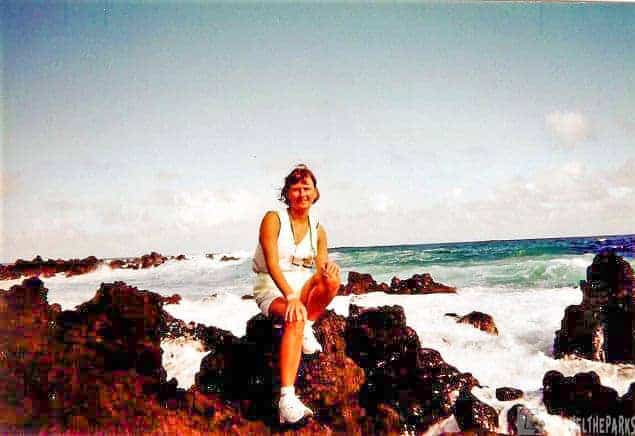
The peninsula of Ke‘anae, mile marker 12, is well-known for being a major taro farm community. We walked through the stunning volcanic basaltic rock formations that line the coast, watching the turbulent waves crashing. The giant waves mesmerized me. The eroded rocks create small tidal pools for marine life.
At mile marker 14, past Kaumahina State Wayside Park, the Honomanu Lookout offers great ocean views before you start down into the valley. At mile marker 17, our guide stopped at the Halfway to Hana refreshment stand to have a sample of the banana bread. Just past Ke’anae Arboretum,this is one of Maui’s hidden gems to try the pineapple smoothies!
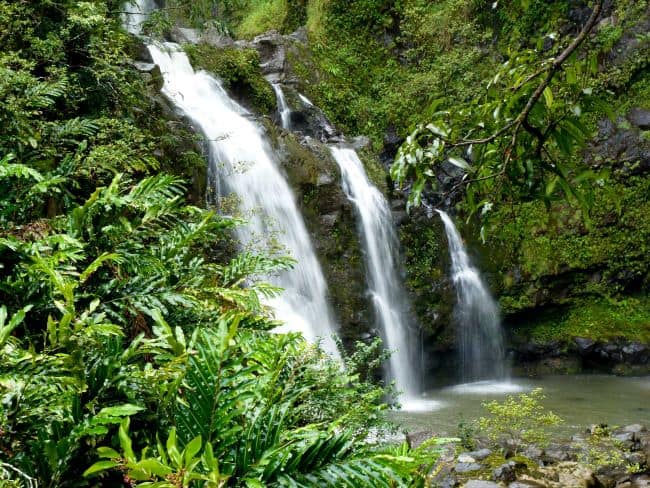
More Waterfalls around Every Turn in the Road
Upper Waikani Falls-At mile marker 21, the Wailua Falls are easy to view from the road but difficult to climb down to the waterfall. A beautiful location, and very rewarding if you’re not afraid to climb a bit. It’s quite slippery, so make sure you wear shoes with grips (no flip-flops). They referred this series of waterfalls to as the “Three Bears” because three separate falls run parallel to each other.
Pua’a Ka’a Falls is at mile marker 22 in Pua’a Ka’a State Park. It is a perfect spot when driving the road to Hana to take a pit stop with clean restrooms. We climbed up past the lower waterfall on the right-hand side to the upper waterfall. Very tranquil looking down over the succession of mini waterfalls.
Lots of feral cats in the picnic area. Many of them were quite playful. While scratching one cat, a huge kukui nut fell from the 50-foot tree above me. At first, I thought someone had thrown it at me. It packed quite a punch, leaving a bruise I would not soon forget. This is one of the most photographed falls and an incredible swim spot too!
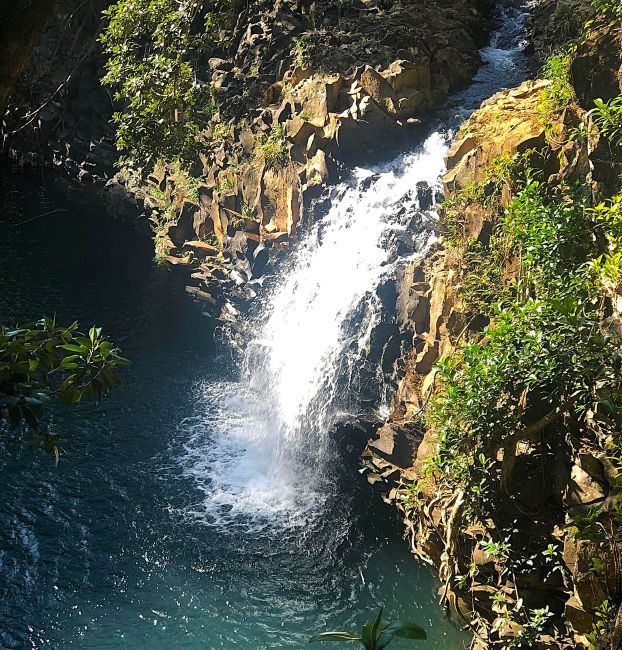
Awe-inspiring Hanawi Falls at mile marker 24 is a series of falls. During low flow times, you can hike the area. The upper falls cascade 30 feet into a plunge pool. The lower cascade plummets 200 feet, but is difficult to hike. This spring-fed falls have a constant flow even during the summer months.
Exploring the Road to Hana: Makapipi Falls
Near mile marker 25, these falls can only be photographed from above the bridge. However, there are splendid view of the pool from the bridge. We stood on the bridge to look directly down at the top of the falls. Not as thrilling as the other waterfalls, but still worth the stop.
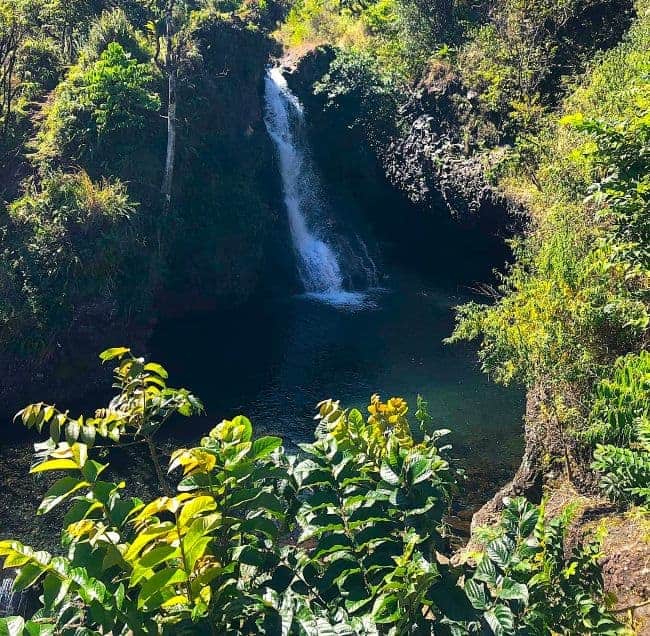
Waiʻanapanapa State Park
This beach has panoramic views and a gorgeous black-sand beach. This was our favorite stop, a gorgeous tropical retreat. Wai’anapanapa means “glistening water”, and is located at mile marker 32. The park has restrooms, a campground, a picnic area and rental cabins. There’s lots of other interesting things to do in this 122-acre park. You can explore the lava tubes and legendary caves, anchialine pools, natural stone arches, sea stacks, and blowholes. Surrounded by volcanic lave rock cliffs, you get amazing views of Pa’iloa beach from the headlands.
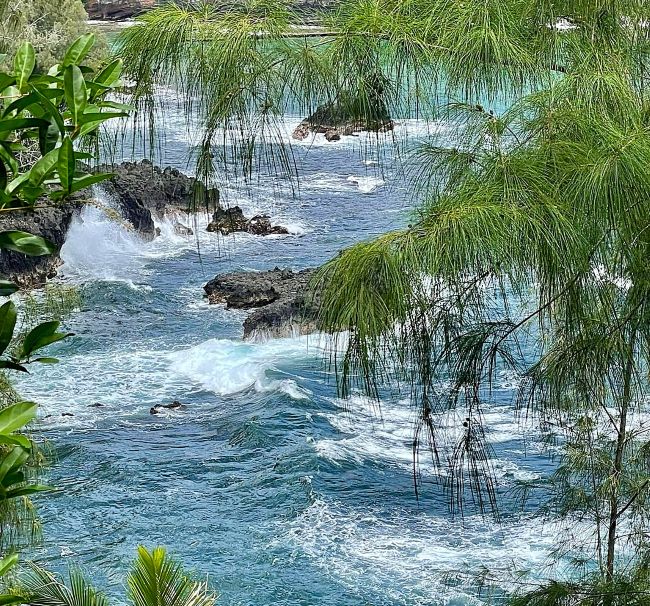
We descended on a short trek to a small sandy beach. The deep blue color of the ocean contrasts beautifully with the black, pebbled shoreline. Just listen to the waves crashing against the jagged coast. The “sand” is actually made up of small pebbles that feel unique between your toes. We could see why swimming here can be dangerous, given the rough surf.
Walk east to the lava tube, ducking your head as the cavern opens into a large room. Natural skylights in the ceiling illuminate the otherwise dark space. Be sure to take the path up the cliffs on the far side of the beach. Venturing farther down the rocky shoreline to the blowhole is worth the effort if the surf and tide are high. Today, we saw it shoot short streams of water; however, it wasn’t very impressive.
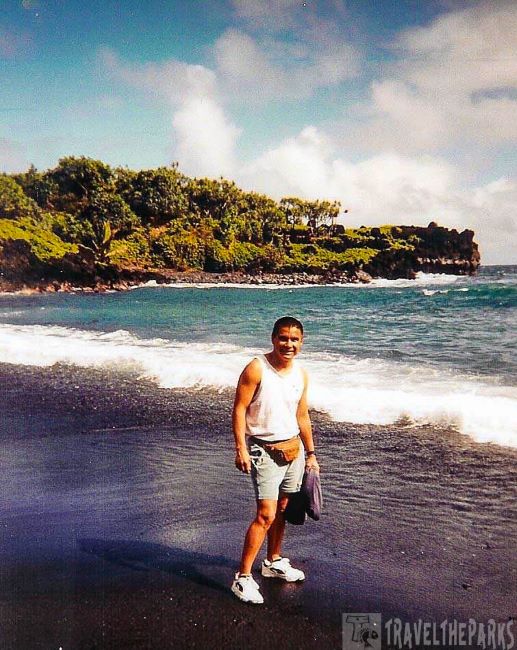
Note: they have implemented a ticketed entry system. It requires advanced reservations at least one day in advance and only 14 days. You pay $10 for your vehicle and an additional $5 per person in the vehicle.
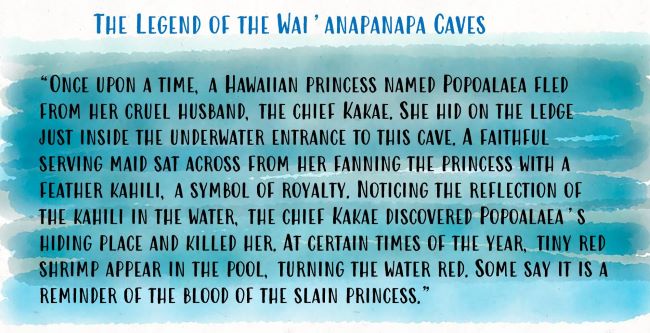
Scenic drive on the Road to Hana: Wai’anapanapa Legend
Our guide took us down the short loop hike to the beautiful freshwater pools, telling us the legend of the Hawaiian princess. The legend of Waiʻānapanapa caves can be read on a large sign at the trailhead. It is interesting how the freshwater sits on top of the saltwater, and a dip in the refreshing pool was a welcome relief from the heat. Today, the pools are inaccessible and fenced.
We ate a breakfast of croissants, muffins and fruit with coffee and juice at one of the picnic tables. While eating our snack, the guide told us Pele’s Curse is the belief that anything natively Hawaiian, such as sand, rock, or pumice, will affect bad luck on whoever takes it away from Hawaii. Every year, packages arrive with the artifacts being returned to the island.
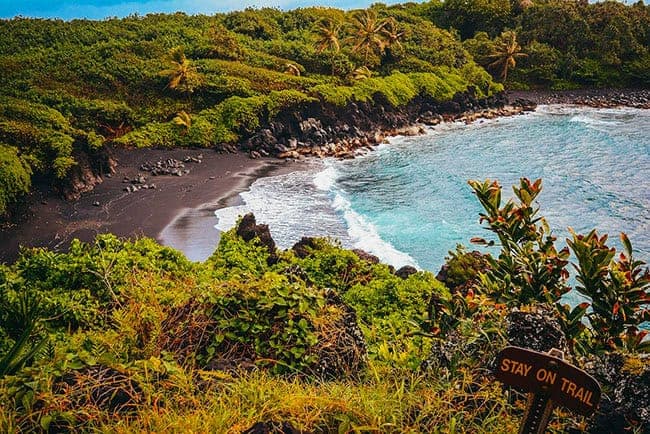
Discovering Hāna, the End of the Road
After 52 miles, you reach the end of the road. Hāna Town is one of the most isolated communities in Hawaiʻi. For us, the highlight of the day was a visit to Hasegawa’s General Store. This legendary store in Hāna carries a wide range of goods—everything you could need. Brothers Shoichi and Saburo Hasegawa founded this historic Hāna landmark in 1910, and it was immortalized in song in 1961.
The original store burned down in 1990 and was later rebuilt. We wandered the aisles of groceries, plumbing supplies, and even liquor. Items are more expensive because of the logistics of getting supplies here, but we still picked up a few souvenirs. We loved the nostalgia and smiled as we hummed a few bars of the song.
“As you walk through the doorway, what a great surprise!
There’s a wonderful variety of merchandise,
It’s all spread out there before your eyes,
At the Hasegawa General Store.” by Paul Weston
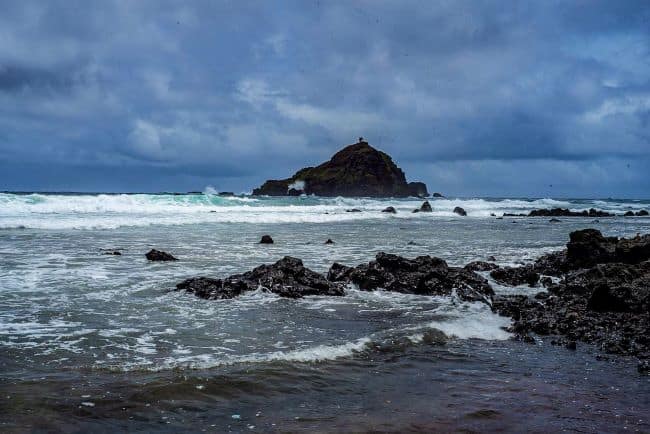
Intimate Beaches of Hāna
When you pull off the Hāna Highway onto the loop road, you’ll come across the first beach called Koki Beach. It has a marvellous view of ʻĀlau Island in the distance. The beach sand is fine, quite soft, but dark reddish because of the cinder hill, Ka Iwi o Pele. You can walk into the water for about 40 yards, and it’s only waist-deep. This makes it excellent and safe for adults and kids to enjoy the water.
The horseshoe-shaped Hamoa Beach is one of my favorite beaches in Hawaiʻi. It features a long stretch of pristine sand, ringed by lush green foliage. There is a reasonable amount of parking along the shoulders of the road, with stairs at street level leading down to the beach.
The soft salt-and-pepper sand between your toes feels amazing—so much so that James Michener, the author of Hawaiʻi, considered Hamoa Beach the most beautiful beach in the Pacific. It’s an excellent spot for surfing, body surfing, and boogie boarding; however, the current can be strong, so beware of riptides.
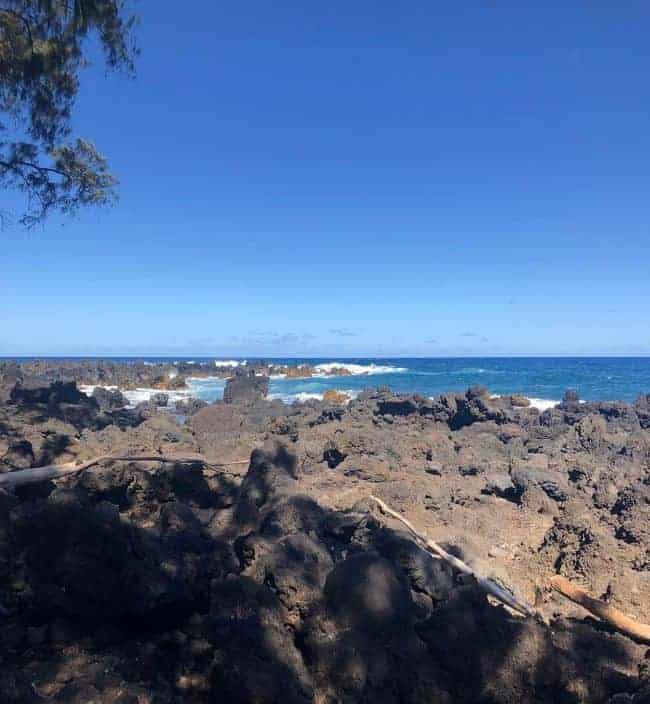
Hāna Cultural Center and Museum
We stopped on our return trip to see the Hāna Cultural Center & Museum to learn about Hawaiian culture. The outdoor exhibits are the Hale Waiwai (“House of Treasures”), Hāna Courthouse and Jail, and Kauhale O Hāna. The O Hāna is a reproduction of a traditional Hawaiian family compound. There are artifacts in the museum and a gift shop that sells local arts and crafts. Excellent information about the tsunami of 1946 that devastated the town.
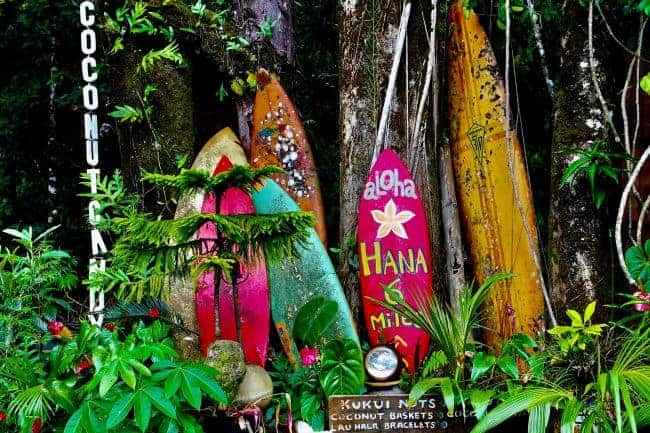
Our tour group stopped at the Hāna Ranch restaurant for a quick lunch. We absolutely loved the ahi tuna poke appetizer. I had the Kalua Pig pork sandwich with coleslaw — delicious! Barry had the mahi-mahi sandwich that he said was yummy, served with fries. This restaurant perched on a hill with magnificent views of the azure ocean. We enjoyed our lunch at a leisurely pace, enjoying the light breeze.
Note: The mile markers start at 50 at Hana Town and begin to decrease on the west side of the island.
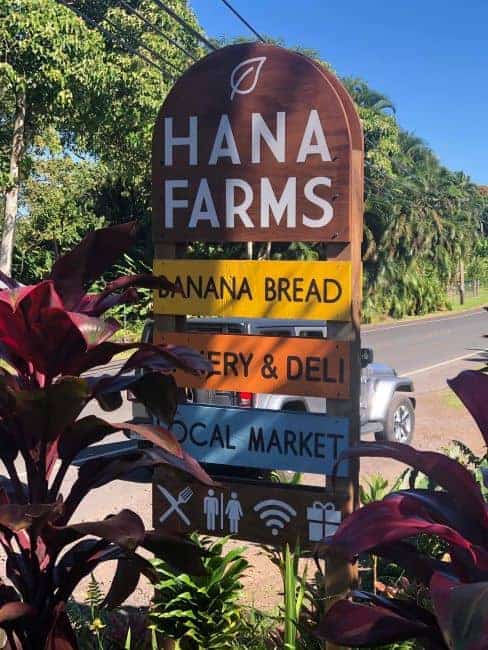
Cascading Wailua Falls
The last major waterfall is 20-minutes outside Hāna at mile marker 45. The waters of Wailua Falls dramatically plunge 80-foot cascading into a deep pool surrounded by lush rainforest. You can easily photograph the waterfall from the road as the Honolewa stream passes directly under the road. Parking is available just after crossing the bridge on the left side. Wailua Falls is Maui’s “most photographed waterfall.” Our tour guide helped us grab a quick photo in front of the falls. If you look to the right of the bridge, there is a quick path to walk down to the pool. Be careful walking the trail. It is very rocky and slippery.
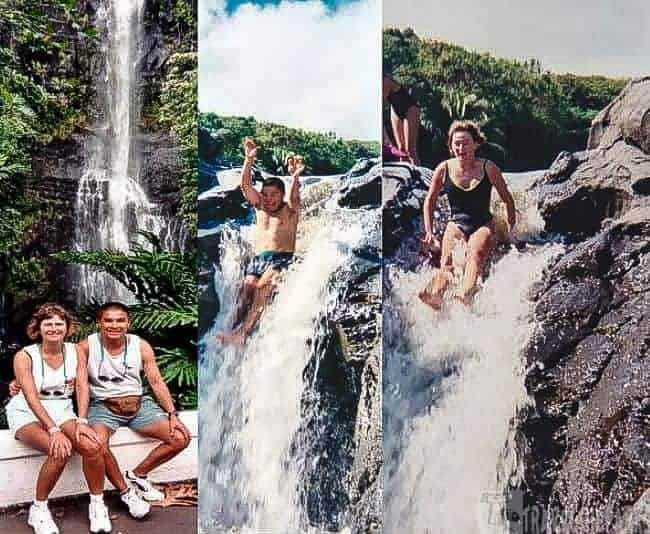
Explore the Kīpahulu District Visitor Center
This region became part of the Haleakalā National Park in 1969 and includes the Pools of ‘Ohe’o. You will need to pay the park entrance fee at the visitor center. The entrance fee is 30-dollars which is good for 3 days. Instead, we recommend purchasing America the Beautiful pass for $80. The pass is good for one year and helps fund our national parks. We currently have a senior lifetime pass for the parks. The visitor center amenities are restrooms, a public telephone, picnic tables and interpretive exhibits. You can reserve campsites through recreation.gov. The campsites are along the rocky coastline.
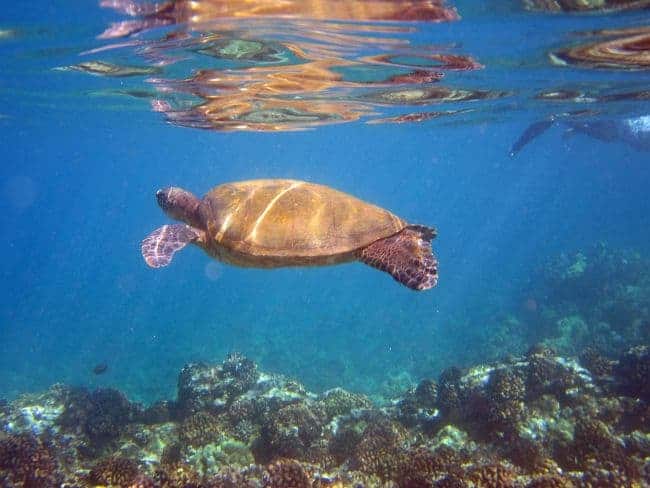
Water slide swim at the Pools of ‘Ohe’o
The pools are the most popular attraction in Kīpahulu. They comprise a series of freshwater pools at the base of several cascading waterfalls. ʻOheʻo (oh-HAY-oh) means “something special,” and this site certainly lives up to its name.
The pools of ʻOheʻo were once referred to as the Seven Sacred Pools, but this was a marketing term created to attract visitors to the remote location. In reality, when water levels are high, there are more than seven pools. At times, the pools are closed by the National Park Service because of heavy rainfall and flash flood concerns.
Today, our guide allowed us to spend 30 minutes sliding down the natural rock slide into the refreshing freshwater pools. Wading shoes are best for navigating the slick rocks. I recommend wearing dry-fit or quick-drying clothing and bringing towels if you plan to venture into the waterfalls. It’s hard to describe in words, but believe me—it’s wonderful!
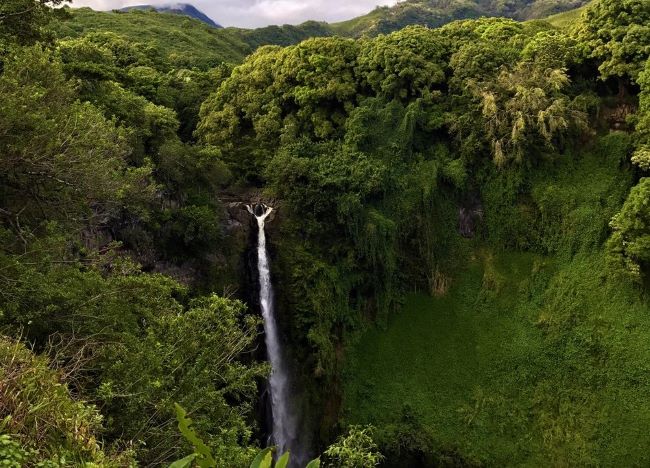
At the junction of the Pīpīwai and Kūloa Point Trails, the National Park Service erected a Hale Hālāwai, which means “meeting house.” The National Park Service plans to begin Hawaiian cultural demonstrations here.
The Kūloa Point Trail is an easy 0.7-mile loop hike to the rugged coastline. This well-maintained trail passes through a grove of Hala trees before reaching outstanding ocean viewpoints at the mouth of the Pools of ʻOheʻo. Along the way, the trail also passes several archaeological sites.
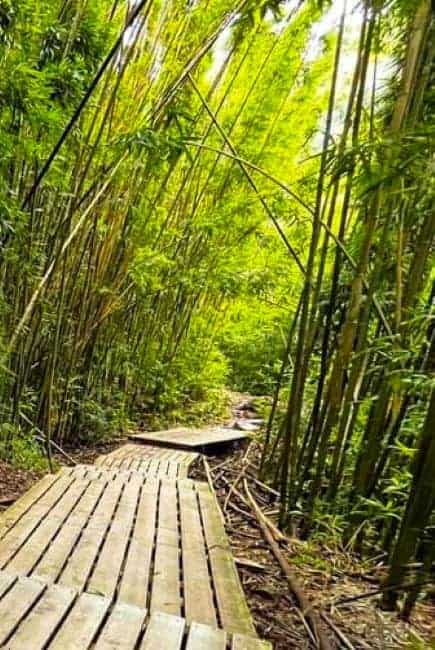
Hiking the Pīpīwai Trail to Waiamoku Falls
On our return trip to Hāna, we hiked the Pīpīwai, or “sparkling waters” trail at mile marker 42 in the Kīpahulu district. It’s a moderate 2-mile out and back trail. Remember to bring bug spray, plenty of water and good hiking boots. The trailhead is inside Haleakala National Park and can be muddy during the wet season. Within the first mile, we gain 700-800 feet in elevation, climbing the rock steps. You first pass a lookout to amazing Makahiku Falls. The 200-foot falls cascade over a green cathedral cliff, disappearing into the forest below. Soon you pass through a fence meant to keep out the wild pigs. Please remember to close the gate.
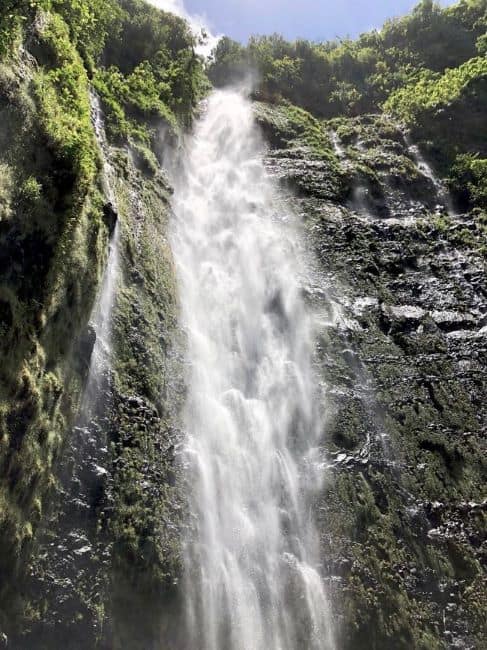
We continued climbing more stairs before stopping to take in the gigantic banyan tree. The tree symbolizes wisdom in Buddhism and eternal life in Hinduism. Crossing two bridges, the trail continues before reaching the majestic bamboo forest—a favorite memory. The sound of the bamboo stalks bumping against each other was absolutely mesmerizing.
Once you exit the forest, you wade across a small stream before the trail opens up to a stunning view of Waimoku Falls. It felt like stepping into Jurassic Park. The mountainside waterfall drops 400 feet, while wispy clouds and emerald-green ferns cling to the cliffs. The surrounding rainforest only adds to the mysterious beauty. It was truly breathtaking.
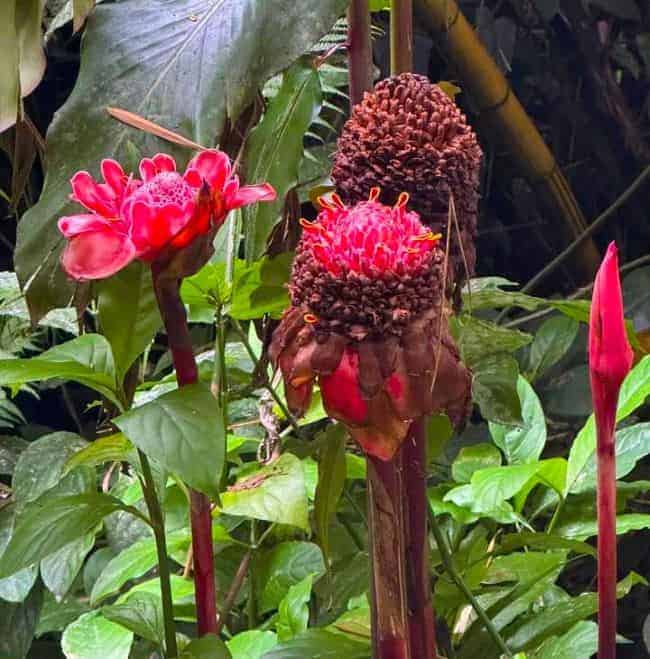
Kīpahulu Lindbergh’s Last Resting Place
Kīpahulu Park is a little over a mile west of the Kīpahulu Visitor Center. Charles Lindbergh, who saw much of the world, was so enchanted by the area that he chose to be buried in the Kīpahulu section of Haleakalā National Park. Tucked away in a quiet, off-the-beaten-path setting is Charles Lindbergh’s grave. He passed away from lymphoma in 1974.
His simple headstone is engraved with the words, “If I take the wings of the morning and dwell in the uttermost parts of the sea,” taken from Psalm 139:9. Nearby stands the humble Palapala Hoʻomau Church at mile marker 41. Missionaries built the church in 1857 using local resources, including limestone coral. The site offers exquisite views of the coastline, and its peaceful, pastoral setting makes it a wonderful place to stop and reflect.
Most travellers of the highway will turn around at this point and return the way they came, but the tour vans will continue towards the Pi’ilani Highway.
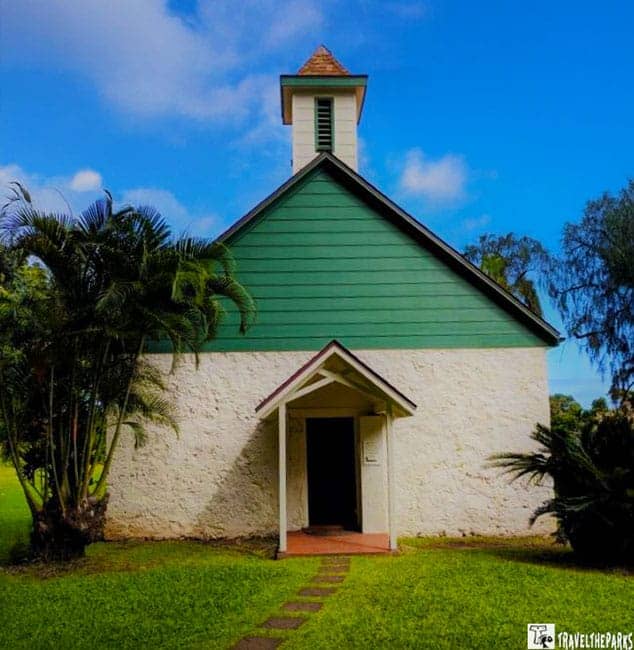
Backside of the Road to Hana
If you take the van tour that circumnavigates the island, the scariest part of the road—for me—was Lelekea Bay. Here, the narrow one-lane road hugs the cliffside. If you have a fear of heights like I do, don’t look out the window. There’s a precipitous hundred-foot drop and no guardrails on this blind curve, making it feel like you have only inches to spare.
From mile marker 33 to mile marker 38, the road turns to gravel.
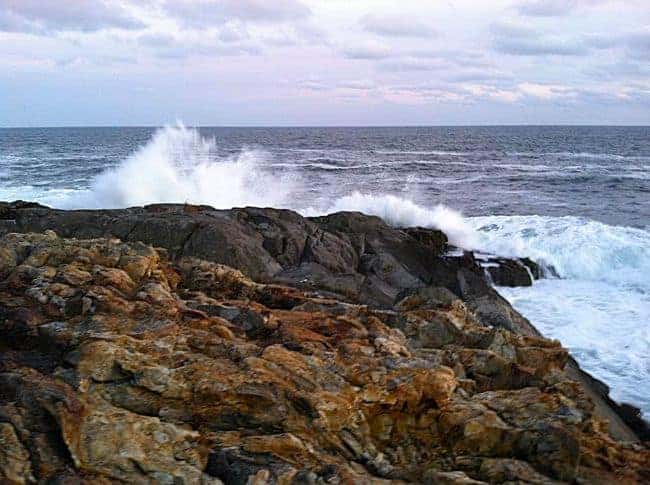
Driving the road to Hāna, you encounter a strikingly contradictory landscape on the east side of Maui. In less than an hour, you can move from one of the wettest places on Earth to an area that receives only about 16 inches of rainfall per year. On this rain-shadow side, the island takes on a surreal, desert-like quality. The unspoiled beauty of this coast is truly priceless.
At Kalepa Bridge, the Hāna Highway becomes the Piʻilani Highway (Hwy 31). This remote section of road offers charming vistas, including isolated pebble beaches, gently sloping dry grasslands, and barren, eroded canyons.
Note: Check with your rental car company some will not allow you to drive this section of road.
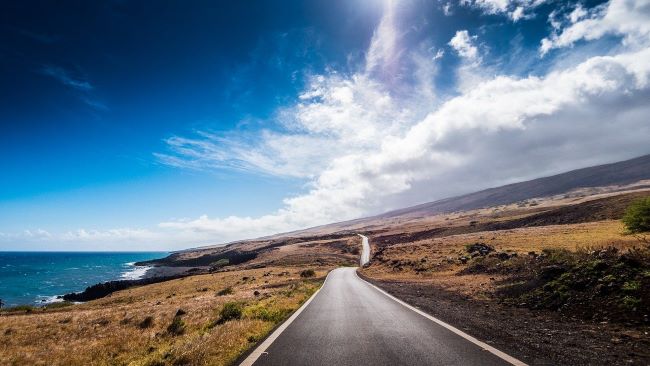
Hidden Secret Alelele Falls
At mile marker 38, you cross a white bridge with “Alelele Bridge” stamped into it. The tour van parked on the left side of the bridge, facing the cliffs. Just 0.3 miles out and back, an oasis awaits at Alelele Falls. The 50-foot waterfall lies in an idyllic forest, with a spring-fed pool perfect for a quick dip. Depending on the rainfall, the falls can be a roaring torrent or a gentle trickle. We only spent enough time for photos before continuing down the road.
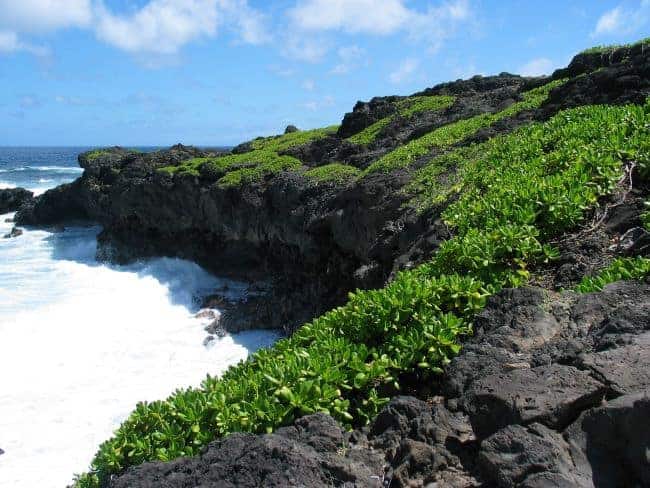
Step Back in Time at Kaupō Store
At mile marker 35, you’ll have reached the historic Kaupō Store, established in 1925. The store caters to dazed tourists, most of whom have just completed the road to Hāna, enduring the hair-raising cliff-side twists and turns on the gravel highway.
Stepping into the Kaupō Store felt like stepping back in time. Upon entering, our eyes were immediately drawn to the wall behind the rusty cash register, lined with antique bottles, old-fashioned clocks, and signs from a bygone era. I especially loved the neatly displayed vintage cameras that once belonged to the store’s former owner, Nick Soon. The store is a welcome reprieve in this remote location—a small slice of civilization where we enjoyed ice cream before returning to the tour van.
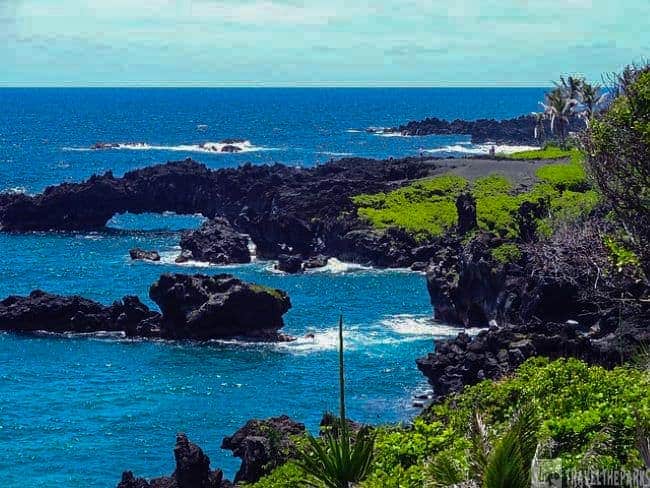
Dramatic Landscapes and Panoramas
At mile marker 31, our guide told us about the Pu’u Maneoneo Petroglyphs & Village Ruins on the 82-acre Nu’u Refuge managed by the Hawaiian Islands Land Trust on the Kaupō ranch. You can view the petroglyph rock art just inside the gate. However, the village ruins are a longer hike on an unmarked trail through dense forest and should only be attempted by seasoned hikers.
The Pokowai Sea Arch at mile marker 29 was formed when flowing lava from the volcano collided with the chilly waters of the Pacific. The arch is slowly being eroded by the continuous pounding surf. We spent a few moments watching the waves crash over black volcanic lava formations before moving on.
The tour guide made a brief stop at Manawainui Gulch. Here, an ancient lava flow from Haleakalā created a massive chasm. The group was so excited when the guide pointed out a Hawaiian monk seal taking a nap on the beach.
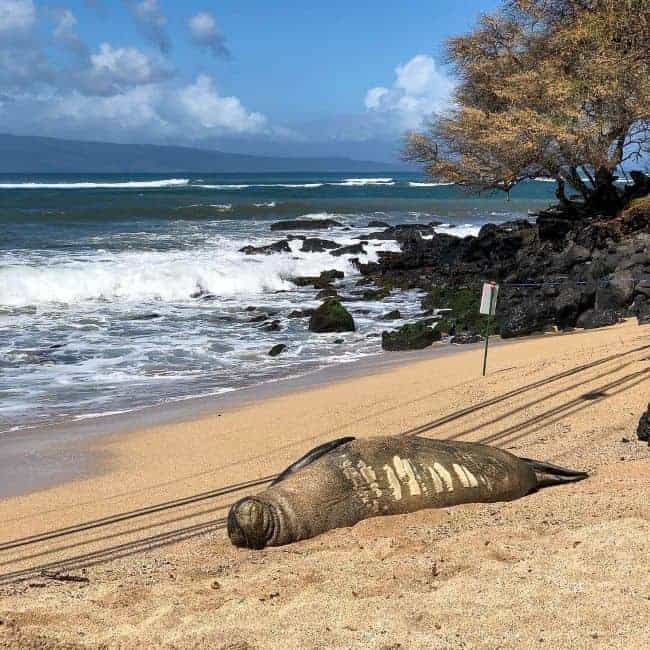
MauiWine Tasting Room
The winery is on the ʻUlupalakua Ranch in upcountry Kula at mile marker 15. At an elevation of 1,800 feet, this microclimate is ideal for growing grapes. This was the last stop on our full-day tour. The winery began humbly in 1974, when Emil Tedeschi partnered with C. Pardee Erdman, the owner of ʻUlupalakua Ranch. The original Tedeschi name was changed to MauiWine in the 1980s. Today, they grow a variety of grapes, including Syrah, Malbec, Grenache, Viognier, Chenin Blanc, Rosé, and Gewürztraminer.
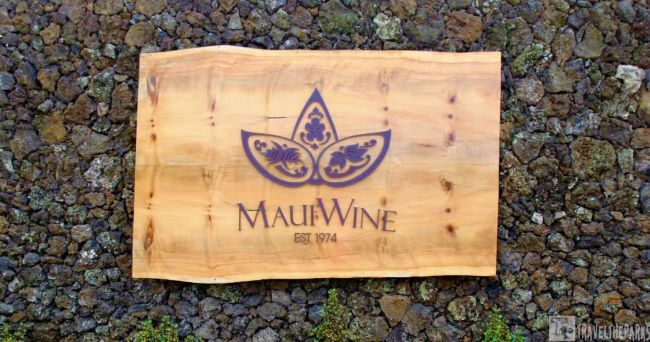
This 23-acre tranquil estate was a welcome end to our day. The tasting room, located in King’s Cottage—built in 1870 to host King Kalākaua—features an impressive wooden bar carved from a single mango tree. Our group enjoyed the complimentary wine tasting, sampling Maui Splash (white; pineapple and passion fruit), Hula O Maui Sparkling Wine (pineapple), Rosé Ranch Cuve (grapes), and Framboise de Maui Raspberry Wine.
The outdoor lanai offers outstanding views of Molokini Crater and the south shore, creating a wonderfully relaxing atmosphere. Maui Splash was our favorite and a great value at $10 a bottle to take home. In addition to complimentary tastings, the winery offers guided tours of the historic estate, production area, and cellars. A brief stop at MauiWine is truly a must!

Final Thoughts: Magnificent Once in a Lifetime Drive the Road to Hāna
On this full-day tour, you cannot possibly see or do everything along the road. I suggest a return trip to do more in-depth hiking to get an immersive experience. It is an adventure worth taking, so consider an overnight in Hāna.
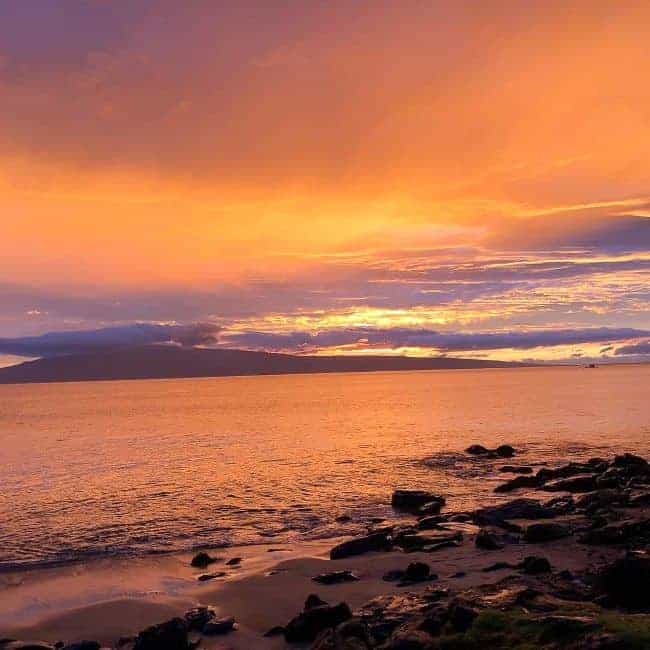
Aloha is used as a greeting in Hawaiʻi, but it doesn’t just mean “hello” or “goodbye.” Aloha embodies an attitude of love, compassion, and respect. Many call the Road to Hāna the “Highway to Heaven,” and truly, it’s the journey—not the destination—that makes driving the Road to Hāna so unforgettable.
Have you driven the Road to Hāna? If not, what do you think you would like best? Share your thoughts with us. We’d love to know your plans! If you already did the drive, what did you enjoy most?

